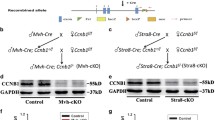Abstract
THE D-type cyclins (Dl, D2 and D3) are critical governors of the cell-cycle clock apparatus during the Gl phase of the mammalian cell cycle. These three D-type cyclins are expressed in overlapping, apparently redundant fashion in the proliferating tissues1,2. To investigate why mammalian cells need three distinct D-type cyclins, we have generated mice bearing a disrupted cyclin D2 gene by using gene targeting in embryonic stem cells. Cyclin D2-deficient females are sterile owing to the inability of ovarian granulosa cells to proliferate normally in response to follicle-stimulating hormone (FSH), whereas mutant males display hypoplastic testes. In ovarian granulosa cells, cyclin D2 is specifically induced by FSH via a cyclic-AMP-dependent pathway, indicating that expression of the various D-type cyclins is under control of distinct intracellular signalling pathways. The hypoplasia seen in cyclin D2−/− ovaries and testes prompted us to examine human cancers deriving from corresponding tissues. We find that some human ovarian and testicular tumours contain high levels of cyclin D2 messenger RNA.
Similar content being viewed by others
References
Sherr, C. J. Cell 79, 551–555 (1994).
Peters, G. J. Cell Sci. (suppl.) 18, 89–96 (1994).
Sicinski, P. et al. Cell 82, 621–630 (1995).
Fantl, V., Stamp, G., Andrews, A., Rosewell, I. & Dickson, C. Genes Dev. 9, 2364–2372 (1995).
Hogan, B., Beddington, R., Constantini, F. & Lacy, E. Manipulating the Mouse Embryo: A Laboratory Manual (Cold Spring Harbor Laboratory Press, Cold Spring Harbor, New York, 1994).
Richards, J. S. Endocr. Rev. 15, 725–751 (1994).
O'Brien, M. J., Wigglesworth, K. & Eppig, J. J. Methods Toxicol. 38, 128–141 (1993).
Johnson, L. D., Albertini, D. F., McGinnis, L. K. & Biggers, J. D. J. Reprod. Fertil. 104, 277–284 (1995).
Roger, P. P., Reuse, S., Maenhaut, C. & Dumont, J. E. Vitam. Horm. 51, 59–191 (1995).
Desjardins, C. & Ewing, L. L. Cell and Molecular Biology of the Testis (Oxford University Press, New York, 1993).
Nakayama, H. et al. Dev. Growth Differ. 38, 141–151 (1996).
Buckley, M. F. et al. Oncogene 8, 2127–2133 (1993).
Bartkova, J. et al. Int. J. Cancer 57, 353–361 (1994).
Inaba, T. et al. Genomics 13, 565–574 (1992).
Bosl, G. J. et al. J. Natl Cancer Inst. 81, 1874–1878 (1989).
Rodriguez, E. et al. Cancer Res. 52, 2285–2291 (1992).
Suijkerbuijk, R. F. et al. Cancer Genet. Cytogenet. 101, 85–93 (1993).
Boland, N. I. & Gosden, R. G. J. Reprod. Fertil. 10, 369–374 (1994).
Fitzpatrick, S. L. & Richards, J. S. Endrocrinology 129, 1452–1462 (1991).
Pelham, H. R. B. Cell 30, 517–528 (1982).
Ausubel, F. M. et al. Current Protocols in Molecular Biology 4.2.4–4.2.6 (Wiley, New York, 1995).
Geng, Y. & Weinberg, R. A. Proc. Natl Acad. Sci. USA 90, 10315–10319 (1993).
Author information
Authors and Affiliations
Rights and permissions
About this article
Cite this article
Sicinski, P., Donaher, J., Geng, Y. et al. Cyclin D2 is an FSH-responsive gene involved in gonadal cell proliferation and oncogenesis. Nature 384, 470–474 (1996). https://doi.org/10.1038/384470a0
Received:
Accepted:
Issue Date:
DOI: https://doi.org/10.1038/384470a0
- Springer Nature Limited
This article is cited by
-
Janus Kinase 3 phosphorylation and the JAK/STAT pathway are positively modulated by follicle-stimulating hormone (FSH) in bovine granulosa cells
BMC Molecular and Cell Biology (2023)
-
Generation of adult hippocampal neural stem cells occurs in the early postnatal dentate gyrus and depends on cyclin D2
The EMBO Journal (2023)
-
The Prognostic Significance of the BIN1 and CCND2 Gene in Adult Patients with Acute Myeloid Leukemia
Indian Journal of Hematology and Blood Transfusion (2022)
-
Large-scale DNA demethylation occurs in proliferating ovarian granulosa cells during mouse follicular development
Communications Biology (2021)
-
Disruption of NREM sleep and sleep-related spatial memory consolidation in mice lacking adult hippocampal neurogenesis
Scientific Reports (2020)





